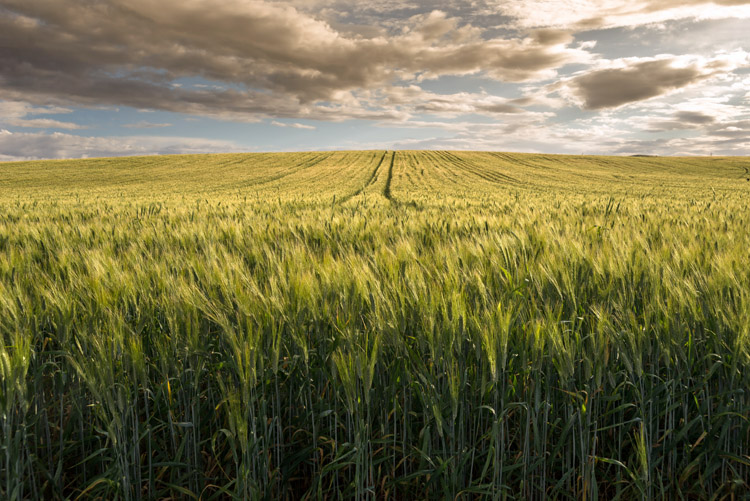Benefits of Agri-Cal
and Super-Cal
On Pastures, Turf
and Field Crops
Agri-Cal Liquid Calcium is being used on field crops, pastures, sports fields, and home lawns around the U.S. and the world. Calcium is a necessary element that all plants need to survive and is one of the 16 essential nutrients. (Photo by Majo)
How Plants Use Calcium
Inside the pant, calcium is used to:
- Enhance photosynthesis and the production of carbohydrates.
- Increases Nitrogen Uptake
- Strengthens the plant's outer wall (cuticle) making it more difficult for pathogens to penetrate
- Neutralizes acidity inside individual cells.
- Calcium necessary for root growth and development and for the uptake of nutrients.
- Soil microorganisms use calcium to maximize their activity
Plant Calcium Deficiencies
- Calcium deficiencies can stunt the growth of plants
- Leads to insufficient chlorophyll production and chlorosis
- Stunted root growth and root penetration
- Reduces the uptake of nutrients
- Cause fruit and leaf abnormalities and more
Sufficient Lime is No Guarantee
Because lime in the soil must be broken down by soil microorganisms before it can be used by plants, even if you have sufficient lime levels, your plants can still show signs of calcium deficiencies. It often takes 6 months to 2 years before lime is available for plant use.
In addition, calcium in lime is not very soluble. It won't travel with the water in soil and even after two year after application over grass, it may not have absorbed more than 3/4" deep. The means the deeper root zone is still unaffected.
Once calcium settles inside the plant it doesn't move or relocate. New plant tissues must have a new supply of calcium. When plants shed roots (grass sheds it roots twice over the course of a year) new calcium is needed for root growth. The shed roots breaks down into organic matter by soil microorganisms that can later be used by plants.
Soil CEC and Calcium
In soil chemistry, "Base Saturation" is a term that is often used. It is derived from 4 major elements used to determine the soil's CEC (Cation Exchange Capacity). The 4 alkaline or "base" (basic) elements are Calcium (Ca++), Magnesium (Mg++), Potassium (K+) and sodium (Na+).
Soils are made up of Clay, Organic Matter, Sand and Silt. Organic matter and clay soils have a negative charge (-) and have the greatest nutrient holding ability. Since opposites attract, the negative charges of the soil attract the positive charged elements. The ++ behind the Ca means calcium has a double positive charge.
How Calcium is Released from Soil
As soil microbes work in the soil they release carbon dioxide (CO2). When CO2 combines with water it forms Carbonic Acid (H2 CO3). The hydrogen (H+) in the carbonic acid displaces and replaces the double charge of the calcium and releases the calcium to be taken up by plant roots.
The higher the energy level of microorganisms the faster the calcium is released.
It is generally accepted that the percentages of each of the elements are: Base Saturation of Calcium 65%; Base Saturation of Magnesium 15%; Base Saturation of Potassium 4%; Base Saturation of Sodium 3% or less. These are not absolutes, but are only a general guidelines and different situations can affect these ratios.
Adding Calcium Carbonate (limestone) will displace the Hydrogen ions, bind the calcium in the soil and raise the soil pH. For the new calcium to be available for plants it must be released from the soil by the work of soil microorganisms.
How Agri-Cal Works

Agri-Cal is a Calcium Chloride product. Chloride is one of the 16 essential nutrients all plants need to live, although in small amounts. Being Chloride instead of Carbonate, it will not raise the soil pH.
A minimum of 10% of Agri-Cal is immediately available calcium. This means the plants can take it up and use it immediately. The remaining part of the Agri-Cal solution is a proprietary blend of organic acids that break down the unavailable calcium so it too can be used by plants. Therefore, Agri-Cal calcium, due to the organic acids, will continue to deliver calcium to plants for weeks to months after application.
University studies perform in Illinois have shown that 1 gallon of Agri-Cal produced an equivalent of 500 lbs of calcium by making the previously unavailable calcium available for plant use. These tests were also preformed in Mississippi with the same results. Different parts of the country with different soil CEC, especially sand soils, will have slightly different results, but all are greatly benefited by the use of Agri-Cal (Super-Cal).
What Soil Tests Don't Tell You About Calcium
Soil tests will generally give the amount of Calcium, often in a "Low to High" format, depending on the lab. It will not give you the amount of calcium that is actually available to your plants. You could be swimming in calcium, but if it is not available your plants will suffer. Agri-Cal ensures that the minute you spray it your plants are getting calcium while quickly making more of the unavailable calcium available to plants.
Just a side note: Calcium and Magnesium work together in tightening and loosening soil. Calcium tends to loosen soil while Magnesium tends to tighten soil. Some soil specialists say that high CEC clay sites, more calcium may be desired, up to 70% to 75% with Magnesium 10% to help loosen soil while low CEC sites may require less Calcium, as low as 60% with Magnesium up to 20% to tighten soil and help with water retention. The Calcium/Magnesium ratio should total approximately 80%. The remaining 20% will be the other nutrients. However, there are also other ways to accomplish greater water retention.

Combining Foliar Blend Biostimualnt (As Well As Turf Formula) with Agri-Cal
Turf Formula has been shown, when combined with Super-Cal, to increase soil microorganism activity by and amazing 3400% in just 24 hours. These tests were conducted by the University of Missouri - Columbia.
Disease pathogens residing on soil and on plant surfaces were reduced by 35% to 80%. Plant health was increased and bushel weight was also increased by an average of 33%. (See Links Below).
When using Turf Formula or Foliar Blend alone, tests showed and increase of microorganism activity by 2000% in three days. There was a significant increase Mycorrhizae fungi, and essential and beneficial fungi that attaches to plant roots in a symbiotic relationship. The Mycorrhizae absorbs nutrients and delivers them to the roots greatly extending the depth and coverage of nutrient absorption. Nutrient uptake was increased by 68%.
Tests showed a nutrient increase by 68% due to the increased microbial activity and their effect on elements in the soil. Turf managers and professional sports field managers have been able to decrease fertilizer use by 1/3 to 1/2 because the microorganisms were breaking down soil elements at an increased rate. For those concerned about runoff of fertilizers, the fact alone that Turf Formula and Foliar Blend can reduce the nutrient additives to soil.
Container Sizes for Agri-Cal and Super-Cal Calcium
Agri-Cal (labeled "Super-Cal" in smaller containers) comes in the following sizes. See the Links at bottom of page for more information:
- quart bottles (labeled "Super-Cal")
- gallon jugs (labeled "Super-Cal")
- 5 gallon boxes (labeled "Super-Cal")
- 55 gallon drums (labeled "Agri-Cal")
- 275 gallon totes (labeled "Agri-Cal")
This page only shows a small portion of the benefits of these products. Please see our pages below on each Agri-Gro Biostimulant and Calcium research to see the affects it has on plants.
- Agri-Gro Turf and Foliar Blend Biostimulant Test Results
- Foliar Blend Lab and Field Test Results
- Turf Formula Lab and Field Test Results
- Super-Cal and Agri-Cal Liquid Calcium Ordering and Information
- Agri-Gro's Biostimulants and Soil Boosters Certified Results
Agri-Cal Calcium back to Lawn Care Academy Home
Share This page:
"I sprayed Agri-Cal Calcium on the pastures, but left some parts unsprayed because I wanted to see if there was a difference. I noticed the cattle were ignoring the unsprayed parts and were eating from the pasture I had sprayed with calcium. It must have been sweeter tasting to them and clearly does work. I am very happy with it." (Via a Telephone Conversation)
Eddie L. - Trion GA

